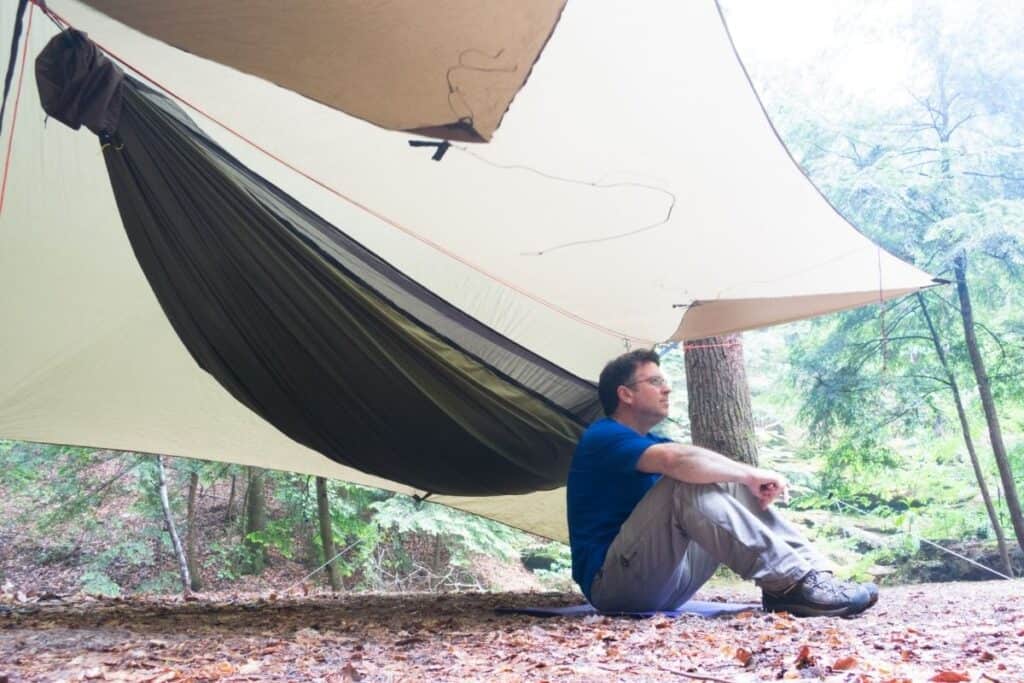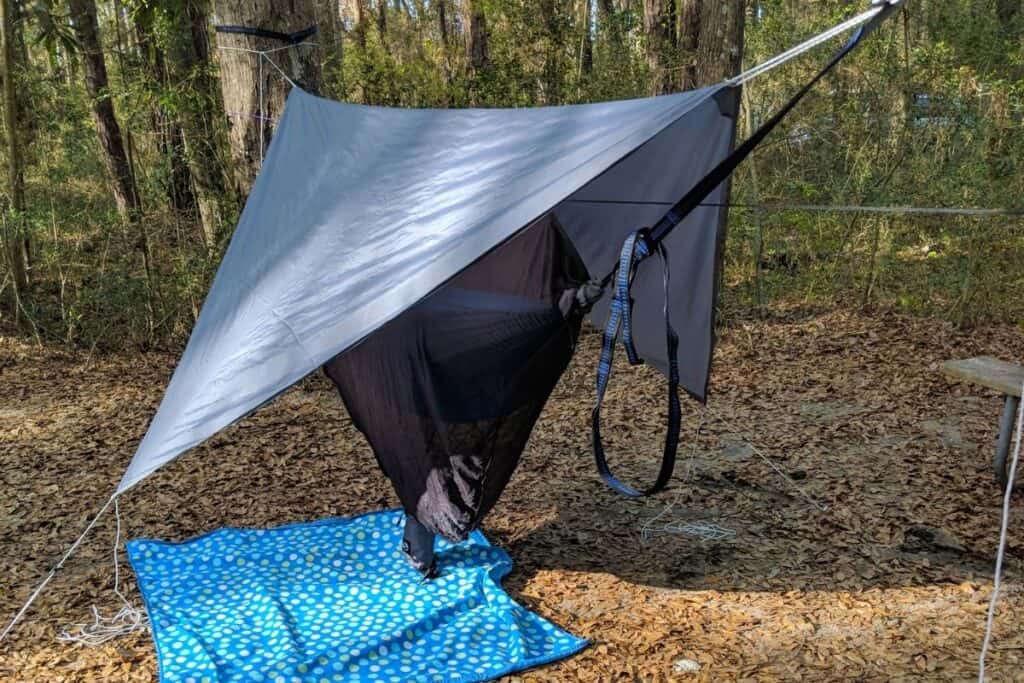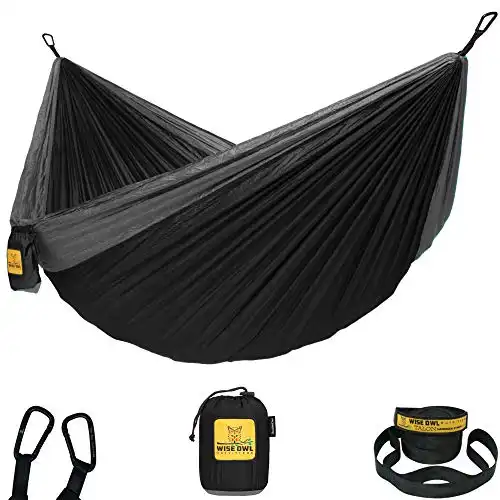
So, you’re thinking about the camping hammock? If you are, let me tell you from my personal experience that hammock camping is one of the most fun, most natural-feeling ways to camp in these great outdoors.
That being said, I get a lot of questions like “are camping hammocks safe?” To tell you the truth, the answer’s not so simple as that.
Hammock camping is just as safe as tent camping as long as your equipment is in good working order and you have selected strong healthy trees from which to hang your hammock.
This is important because, in typical camping, inadequate equipment might mean a colder-than-usual night at the site, but lousy equipment can mean a busted back in hammock camping.
Even so, don’t worry!
This guide will break down exactly why a camping hammock is safe, how to make sure it’s safe, and, as the title suggests, I’ve added some other tips for extra safety below 😉
The Camping Hammock: Why It’s Safe
Here you might be saying, “yeah, that sounds great, but how do I know my camping hammock is safe?” Of course, that’s the very crux of the issue, and I’m going to get into it with you right here.
If the equipment is right and the tree on which it’s hung is good, a camping hammock is one of the safest ways to experience the great outdoors. Most camping hammocks are made of a strong nylon material, which is more than strong enough to support a person’s weight.
Also, the typical nylon straps that allow you to hang your hammock are made to prevent slippage (that is, to increase friction). So long as the trees themselves aren’t faulty, the hammock is made to support more than a person’s weight.

Camping Hammock Safety: The Definitive Guide
Now that we’ve been over camping hammock generally, we’ll deep dive into it. This is the guide for you to make sure your equipment is safe, and that your camp environment is safe.
Checking Your Equipment For Safety
The first thing to check when hammock camping is whether or not your equipment is safe. This is the first line of defense to protect you when going out on a hammock camping trip.
I will always check my equipment at least a week before I go camping. This way, I can be sure to have enough time to replace the equipment if it turns out I’m not confident in its safety.
Safety tip: check your equipment thoroughly every time you go camping. This way, you’ll be sure to monitor your equipment and spot problem areas before they become serious.
In terms of the straps, what I’m looking for is any kind of frays, tears, or otherwise unevenness. Because we’re up in the air, we don’t want to take any risks. If there’s any kind of irregularity in the straps, don’t use them. Get replacement straps.
The same goes for the hammock itself. I’ll look all over for rips. Now, luckily, most of our hammocks are made from a nylon that won’t just rip wide open (a material aptly called ripstop), but it’s best not to risk it. Don’t use a hammock with rips.
Finally, check for UV damage. UV damage seriously messes with your hammock’s integrity, so if you can see heavy UV damage, I would suggest not using the hammock.
Checking Your Environment For Safety
Okay, so let’s assume your hammock is safe.
Congratulations!
You’re one step closer to the great outdoors. However, when you get to the camping site, there’s an equally important step to ensure your safety.
You need to be sure the anchors on which you’ve secured your hammock will stay erect. This may seem obvious, but I’ve seen deceptive anchors that look safe at first but, upon further inspection, show themselves to be quite unsafe.
Widowmakers
A widowmaker is a dead branch on a tree that, when put under a little strain, can snap off.
Widowmakers are the number one most dangerous aspect of hammock camping, hence the name!
However, with a little bit of know-how, you can be totally confident you’re avoiding them.
When looking for a site to put your hammock, be sure the tree on which you’re fastening is alive and well. There are a few easy ways to do this.
- Make sure the trees around your tree are healthy. If all the other trees are healthy and your tree looks healthy as well, it’s probably safe.
- Give the tree you plan to use a shake. If you hear the rubbing of wood, there might be a widowmaker up above that you can’t see.
- Make sure the tree is alive. Sometimes a tree will have greenery that are actually vines that have overtaken a still-standing tree-corpse.
Finally, and this is the most important step, so important it doesn’t even go in the list, never secure your hammock in the dark. This is so important that, if you don’t heed much else on this list, I ask you to heed this.
You must secure your hammock when it’s light so you can see whether or not the supports on which you’re fastening are alive.
Wild Animals
Make sure wild animals aren’t a real problem at the campsite. Typically, you’ll need to put all of your things away in a bear locker or a bear bag that prevents the smell of food wafting during the night.
If you’re car camping, you can put your things away in the car. Pro tip: if you’re in a heavily touristy area, like BANFF or Yellowstone, you might need to hide the food items in a vehicle or bear locker.
Bears in some parks that have come to rely on daytrippers’ food will actively be searching for an easy meal, so make sure that you properly secure your food!
Poisonous Plants
Finally, be sure there are no poisonous plants on your supports. This is mostly for your comfort.
Nothing’s worse than poison ivy all over your hand when you’re trying to go to sleep!
The Weather
Be sure you know what the weather’s going to be like where you’re going. Weather can be the difference between a good time and a terrible time, but on certain occasions, it can be the difference between life and death.
For one, if there’s going to be lightning near you, don’t use the hammock. Tent sleeping is typically okay in bad weather, but hammock camping is too risky.
Second, check if it’s going to be cold. Hammock camping provides less insolation than tent camping, so if it’s cold, you’ll want to bring a quilt or a yoga mat to put underneath you while you sleep.
Third, if there’s going to be some rain, make sure you bring a rain fly! You can secure it above yourself just as if you were a tent and sleep in dryness. A rainfly can also help trap your heat in with you to keep you warm in colder weather.
Camping Hammock Safety: Pro Tips
We’ve gone over the basic skeleton of why hammock camping is safe and how to stay safe while hammock camping. Here is a list of our pro tips for hammock safety.
- Give your equipment a practice run before going out. If you’re unsure whether your equipment is safe, try fastening it to sturdy supports super close to the ground and hanging out in it for a few hours. If it stays, you’re probably good.
- Make lists. If you’re scatter-brained like me, safety can be the last thing you think of. I’ve taken to writing lists a week before camping that includes checking my equipment before I hit the road. I’ve found this helpful.
- Practice hammocking. Your equipment might be safe, but that doesn’t mean you can’t have a bad fall. Many beginner hammock users have reported nasty spills when trying to get in and out of their hammocks. Practice hammock use before leaving!
Recommended Camping Hammock
If you’re looking to purchase your first camping hammock, I’d recommend taking a look at this one from Wise Owl Outfitters. Not only is it a comfortable and strong option, but it’s very cost effective for getting started compared to some of the high-end options on the market.
Best-selling hammock made from high quality heavy duty 210T parachute nylon. This extra soft yet super strong material gives you the most comfortable and relaxing experience ever while not breaking the bank!
The Camping Hammock: Why I Love It
The camping hammock is a terrific choice for anyone wanting an authentic experience of the great outdoors. Why authentic you ask?
Did you know that our human ancestors slept in trees long before the advent of agriculture and their settlement in cities? It’s true! Our earliest ancestors used their ability to climb trees as a way to ensure their safety from the quadruped predators of the night.
In a recent study, scientists found that human beings evolved to prefer safer sleeping locations. One measure of this safety is elevation above the ground!
Thus, when we’re sleeping in a camping hammock we know is safe, there’s a natural feeling of peace that seems to connect us with mother nature and, most beautifully, our sweet dreams.
Nature Calls
I’ve given you all I know about hammock camping, and now it’s your turn to try. Get some quality hammock camping equipment, grab some friends, and begin to learn from the greatest teacher of all, mother nature.
With this guide, you should feel confident hammock camping in any environment all over the world! With love, my friends: go out, meet nature, and hang loose.
Related Articles
If you found this article helpful, then make sure to also take a look at my other related articles!

